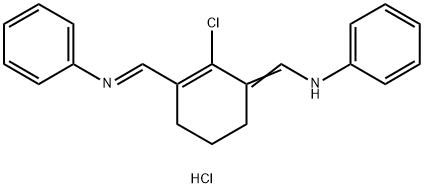|
|
| | 3-CHLORO-2,4-TRIMETHYLENENGLUTACONDIANIL HYDROCHLORIDE Basic information | | Uses |
| Product Name: | 3-CHLORO-2,4-TRIMETHYLENENGLUTACONDIANIL HYDROCHLORIDE | | Synonyms: | N-[(2-CHLORO-1-PHENYLIMINOMETHYL-1-CYCLOHEXENE-3-YLIDENE)METHYL]ANILINE HYDROCHLORIDE;N-((3-[ANILINOMETHYLIDENE]-2-CHLORO-1-CYCLOHEXEN-1-YL)METHYLIDENE)ANILINE HYDROCHLORIDE;3-CHLORO-2,4-TRIMETHYLENENGLUTACONDIANIL HYDROCHLORIDE;BENZENAMINE, N-[[2-CHLORO-3-[(PHENYLAMINO)METHYLENE]-1-CYCLOHEXEN-1-YL]METHYLENE]-, MONOHYDROCHLORIDE;N-((2-Chloro-3-((phenylimino)methyl)cyclohex-2-en-1-ylidene)methyl)aniline hydrochloride;N-((e)-(2-chloro-3-((e)-(phenylimino)methyl)cyclohex-2-enylidene)methyl)aniline hydrochloride;cyclohex-2-en-1-ylidene);N-((2-Chloro-3-((phenylimino) | | CAS: | 63857-00-1 | | MF: | C20H20Cl2N2 | | MW: | 359.29 | | EINECS: | 613-390-8 | | Product Categories: | A;Stains and Dyes;Stains&Dyes, A to | | Mol File: | 63857-00-1.mol |  |
| | 3-CHLORO-2,4-TRIMETHYLENENGLUTACONDIANIL HYDROCHLORIDE Chemical Properties |
| Melting point | 224 °C (dec.)(lit.) | | storage temp. | under inert gas (nitrogen or Argon) at 2-8°C | | solubility | DMF: 0.25 mg/ml; DMSO: 3 mg/ml; Ethanol: 1 mg/ml | | form | A solid | | InChI | InChI=1S/C20H19ClN2.ClH/c21-20-16(14-22-18-10-3-1-4-11-18)8-7-9-17(20)15-23-19-12-5-2-6-13-19;/h1-6,10-15,22H,7-9H2;1H/b16-14?,23-15+; | | InChIKey | VFKQWKQWRNVXTA-LPYKZFQHSA-N | | SMILES | C(=C1CCCC(/C=N/C2C=CC=CC=2)=C1Cl)NC1C=CC=CC=1.Cl |
| Hazard Codes | Xi | | Risk Statements | 36/37/38 | | Safety Statements | 26-36 | | WGK Germany | 3 |
| | 3-CHLORO-2,4-TRIMETHYLENENGLUTACONDIANIL HYDROCHLORIDE Usage And Synthesis |
| Uses | N-((2-Chloro-3-((phenylimino)methyl)cyclohex-2-en-1-ylidene)methyl)aniline hydrochloride is a useful research chemical. | | Description | 3-CHLORO-2,4-TRIMETHYLENENGLUTACONDIANIL HYDROCHLORIDE is a building block, it has been used in the synthesis of cyanine-containing dyes.
| | Uses | diagnostic assay manufacturing
hematology
histology | | Synthesis | Phosphoryl chloride (11.0 mL, 120 mmol) was slowly added dropwise to anhydrous N,N-dimethylformamide (13.0 mL, 170 mmol) via a pressure-balanced addition funnel at 0 °C under stirring. After the dropwise addition, stirring was continued for 30 min. Subsequently, cyclohexanone (5.50 mL, 53.0 mmol) was added to the reaction system and the mixture was heated to reflux and maintained for 1 hour. After completion of the reaction, the system was cooled to 20 °C. At this temperature, a pre-formulated aniline/ethanol [1:1 (v/v), 180 mL] mixture was slowly added dropwise to the reaction mixture. After the dropwise addition was completed, the reaction was vigorously stirred at 20 °C for 30 min. The resulting dark purple reaction mixture was poured into a pre-cooled mixed solution of H2O/HCl [10:1 (v/v), 110 mL] and subsequently placed in an ice bath for 2 hours to crystallize. The crystals formed were collected by filtration, washed sequentially with cold water and ether, and finally dried under vacuum to afford the target product N-[(3-(anilinoiminomethylene)-2-chloro-1-cyclohexen-1-yl)methylene]aniline hydrochloride (14.8 g, 97% yield) as a dark purple solid. The product was characterized by 1H NMR (d6-DMSO, 250 MHz): δ 11.2 (s, 2H, NH), 8.55 (d, J = 14.0 Hz, 2H, CH olefin), 7.68 (d, J = 5.0 Hz, 4H, Ar-H), 7.44 (t, J = 7.0 Hz, 4H, Ar-H), 3.03 (t, J = 6.0 Hz. 4H, CH2-CH2), 2.05-1.98 (m, 2H, CH2-CH2).IR (ATR) spectrum showed characteristic absorption peaks located at 1609 (C=N), 1562, 1457, 1267, 1179, 752, 683, 565 cm-1.Mass spectrometry (ESI) analysis showed m/z: 323.22 [M+]. The melting point was determined to be 226-231 °C. | | References | [1] Journal of Sulfur Chemistry, 2014, vol. 35, # 1, p. 42 - 56
[2] Journal of Fluorescence, 2012, vol. 22, # 2, p. 719 - 727
[3] Patent: US2013/149252, 2013, A1. Location in patent: Paragraph 0135
[4] Patent: US9370589, 2016, B2. Location in patent: Page/Page column 23; 24
[5] Patent: EP1223197, 2002, A2. Location in patent: Example 18 |
| | 3-CHLORO-2,4-TRIMETHYLENENGLUTACONDIANIL HYDROCHLORIDE Preparation Products And Raw materials |
|